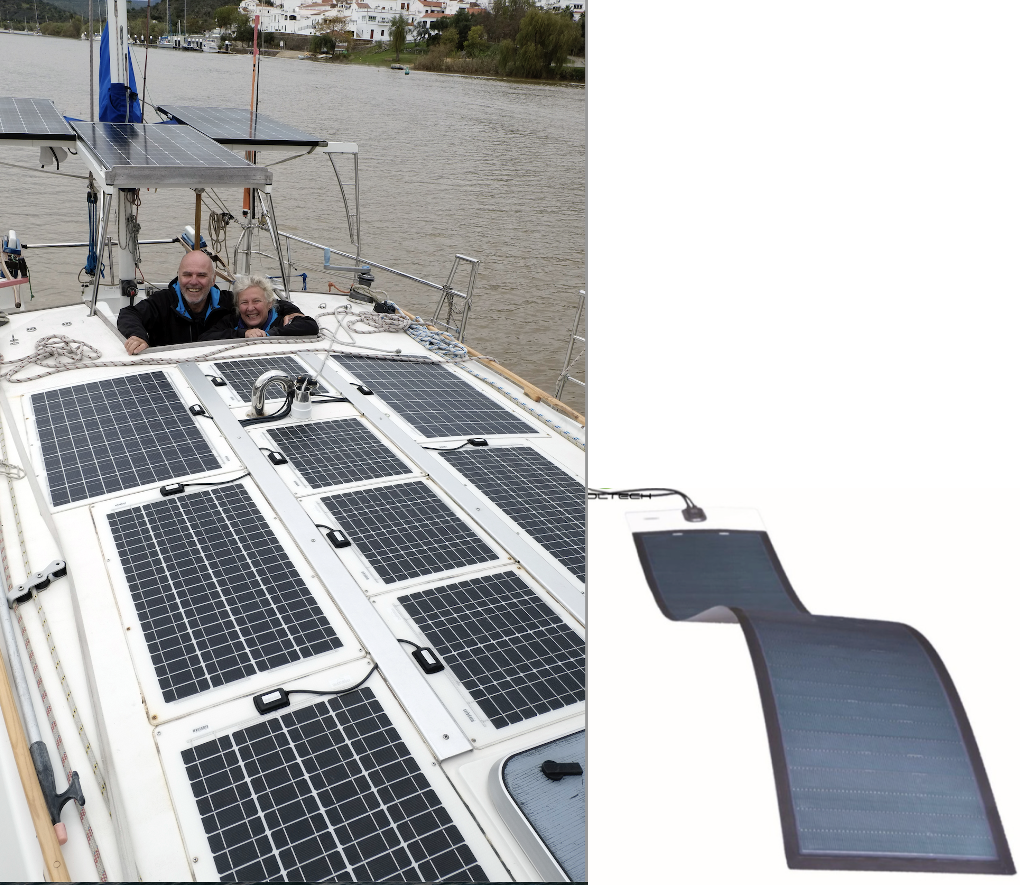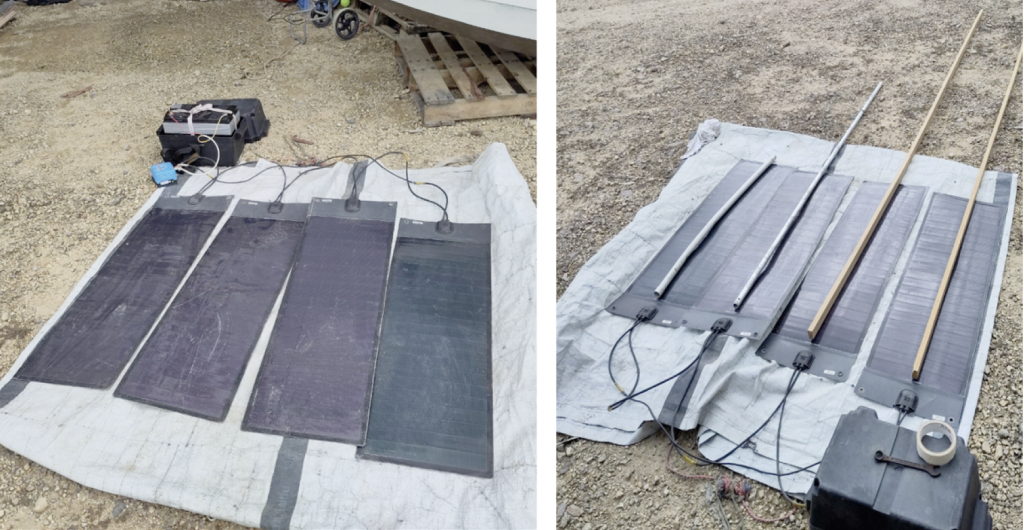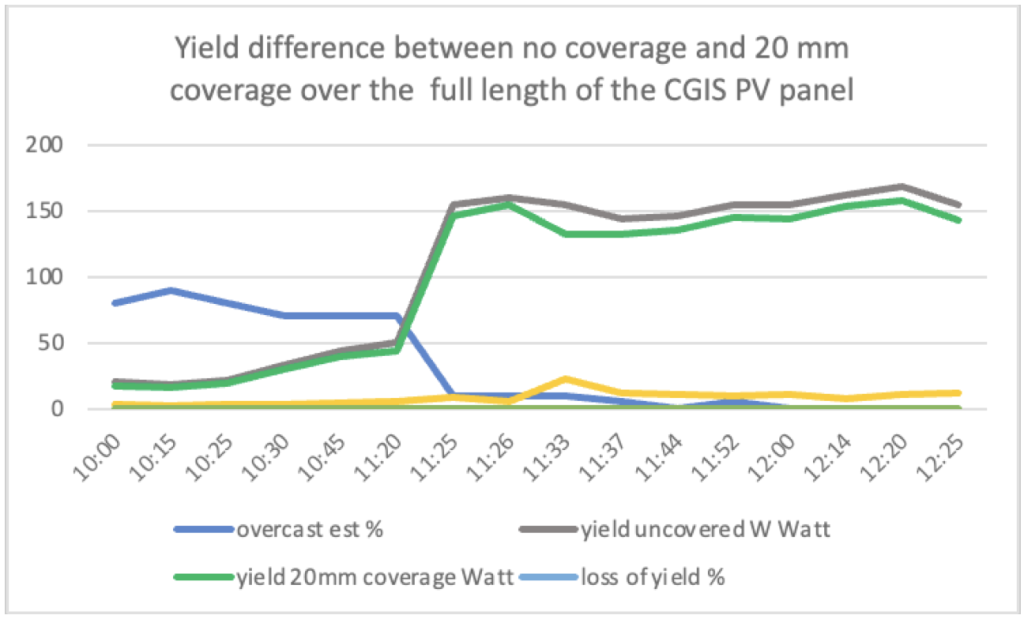There are many innovations in the solar industry, but only some reach the market and are spread. And, will they get interesting for boats? Some years ago a new flexible and thin solar panel seems to stand up. It is often called CIGS (Copper Indium Gallium Selenide) thin film panels. They were originally developed for roofs. But, skippers, yacht owners (and people with flat roofs), attention here! The efficiency of CIGS solar panels has improved!
Yachts normally have limited space for solar panels. So in general the most efficient panel (20+%) is used. Sinoltech http://sinoltech.com/eproducts/?id=8 now delivers thin film CIGS panels with a rated maximum efficiency of 16.5%. This lesser efficiency could be beaten by the great property of CIGS that it doesnot loose much yield when there are little shadows of lines or other rigging, because the latter panels are hardly sensitive to some shadow here and there.
Anti-skid
The regular silicon PV deckpanels are covered with an anti-skid layer. The CGIS panels have no anti-skid and can be slippery. Especially on a monohull yacht, easily heeling 20 degrees, precautions should be made.

According to the CE standard the deck should have every 7-10 cm an anti-slip profile. Will we put that standard also on existing yachts? Then we first evaluate the situation.
The CGIS panels will be mounted on the saloon deck. This deck is not often used to walk on. It will only be used close to the mast, or, in case of setting a reef, a short time at the aft of the saloon deck. These areas will not be covered with panels.
Nevertheless, also in the ‘dead’ area, when a crew member will only be standing by exception, we should create some anti-skid. Therefore, there will be put 20 mm anti-skid tape over the full length of the CIGS panel.
The question
This panel is 345 cm wide, so the maximum space between two anti skid areas will be 16 cm. The effective width of the panel is 31 cm. So the 2 cm coverage would result in a 6.5% less effective surface.
In this field test we will find out.
The main question is:
How much loss will a 20 mm coverage over the full length of the panel create?
More specific:
- Will this coverage lower the yield of the panel seriously?
- Will this coverage lower much more than the 6.5% effective surface coverage?
- Are there any other side effects?
Field test
For this field test four older panels of the catamaran SV Alcazar are used. They are 108 X 34 cm, with an effective PV surface of 96 X 31 cm. They are rated 200 Watt in total, but “They are a bit abused perhaps”, skipper Jack commented.
The MPPT is the Victron Smart Solar. The input from the panels is in the 48 volt range, the output is in the 12 volt.
The battery used is a 12.8 Volt (nominal) LFPO4 battery of 100 Ah. At the start the battery was 12.7 V, at the end of the test 13 Volt.
In stead of a 20 mm tape, pieces of wood are used, This way it was possible to make the measurements ‘before’ and ‘after’ the coverage within 10 seconds. Nevertheless, when the cloud passes before the sun, also these 10 seconds can be long and make a good comparison impossible. In these cases the measurement was postponed untill the cloud situation was more stable. This explains the differences in the periods between the measurements.
The test is made in Panamarina, Panama. So in the tropics. The date was February 10, so in the dry season.

The total duration of the test was 2 ½ hours, from 10 to the astronomical noontime. 10 o’clock is perhaps early to begin, especially in the tropics, because in the morning there is normally much overcast. Important is the moment that the sun starts ‘burning away’ this overcast. The test is continued till 12:30, when the sun makes the smallest angle. That is on 12:30 Panamanian time (Panama follows the EST). Now in February the sun will not come to the zenith, the declination is a bit more than 10 degrees at noontime.
We will see that the 10 degrees angle doesnot matter mucht. The 30 degrees angle is of importance, when the sun is strong enough to clear the clouds.
Here under you find the table with the test results.

Some remarks
Generally the sun gets strong when the angle is about 30 degrees. Compared to 10 degrees, the loss in the yield caused by its angle is geometrically less than 15%. Of more importance, from 30 degrees and less, the heavy tropical clouds clear up more and more, so that improves the yield significantly. This is at 11:20-11:25. Based on my personal experience, most clouds are usually cleared before 11 o’clock. It was just this day that the overcast was heavy.
The panels are older, a bit damaged, so they don’t deliver the rated 200 Watt, on the other hand, the four panels are set in serial and deliver in the 48 Volt range.With that high voltages, I guess that there won’t be any loss from the MPPT. Losses an MPPT could have when the panels would be 12 volt So perhaps the numbers are a bit higher.
The panels get hot, once even to about 60 degrees Celsius, so too hot to walk on it with bare feet.
The measurement of 11:33 deviates strongly from the other ones in the results with a large yield. A false measerement? If we donot count this measurement, the overall percentage would be 6.93 %.
Outline and conclusion

The graphics above present already:
- When covering the panel with 20 mm tape over it’s full length, the loss will probably be 7%, and most negatively be between 7 and 8 procent.
- When the sun’s angle on the surface is 30 degrees and less and (subsequently) the clouds disappear, the yield is booming and the percentage of the loss is bit smaller.
- The older (“abused”) panels give lower yield than rated. And, probably the 48 Volt PV feed to the MPPT could give a bit positive influence to the yield. But these both systemic biases are not relevant to the main question, because this is about the percentage of loss.
The final conclusions about the loss are easy: The coverage of this 20 mm tape reduces the effective surface with 6%, and the loss of the yield is most probably 7% , perhaps between 7 and 8%.
So if we deduct the 7% from the rated efficiency of the Sinoltech panels, the 20 mm anti skid tape will reduce the panels efficiency from the rated maximum of 16.5 to about 15.4%.
